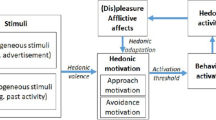Abstract
Although the automotive industry has been among the sectors that best-understands the importance of drivers’ affect, the focus of design and research in the automotive field has long emphasized the visceral aspects of exterior and interior design. With the adoption of Advanced Driver Assistance Systems (ADAS), endowing ‘semi-autonomy’ to the vehicles, however, the scope of affective design should be expanded to include the behavioural aspects of the vehicle. In such a ‘shared-control’ system wherein the vehicle can intervene in the human driver’s operations, a certain degree of ‘intrusive feelings’ are unavoidable. For example, when the Lane Keeping Assistance System (LKAS), one of the most popular examples of ADAS, operates the steering wheel in a dangerous situation, the driver may feel interrupted or surprised because of the abrupt torque generated by LKAS. This kind of unpleasant experience can lead to prolonged negative feelings such as irritation, anxiety, and distrust of the system. Therefore, there are increasing needs of investigating the driver’s affective responses towards the vehicle’s dynamic behaviour. In this study, four types of intrusive feelings caused by LKAS were identified to be proposed as a quantitative performance indicator in designing the affectively satisfactory behaviour of LKAS. A metric as well as a statistical data analysis method to quantitatively measure the intrusive feelings through the vehicle sensor log data.
Similar content being viewed by others
References
Bishop, R. (2005). Intelligent Vehicle Technology and Trends. Artech House. Norwood, Massachusetts, USA.
Blaschke, C., Breyer, F., Färber, B., Freyer, J. and Limbacher, R. (2009). Driver distraction based lane-keeping assistance. Transportation Research Part F: Traffic Psychology and Behaviour 12, 4, 288–299.
Cha, S.-H. (2007). Comprehensive survey on distance/similarity measures between probability density functions. Int. J. Mathematical Models and Methods in Applied Science 1, 4, 300–307.
Chang, H.-C., Lai, H.-H. and Chang, Y.-M. (2006). Expression modes used by consumers in conveying desire for product form: A case study of a car. Int. J. Industrial Ergonomics 36, 1, 3–10.
Duda, R. O., Hart, P. E. and Stork, D. G. (2001). Pattern Classification. 2nd edn. John Wiley & Sons. Hoboken, New Jersey, USA.
Eichelberger, A. H. and McCartt, A. T. (2016). Toyota drivers’ experiences with dynamic radar cruise control, pre-collision system, and lane-keeping assist. J. Safety Research, 56, 67–73.
Ersal, I., Papalambros, P., Gonzalez, R. and Aitken, T. J. (2011). Modelling perceptions of craftsmanship in vehicle interior design. J. Engineering Design 22, 2, 129–144.
Freedman, D. and Diaconis, P. (1981). On the histogram as a density estimator: L2 theory. Zeitschrift für Wahrscheinlichkeitstheorie und Verwandte Gebiete 57, 4, 453–476.
Gkouskos, D. and Chen, F. (2012). The use of affective interaction design in car user interfaces. Work 41, Supplement 1, 5057–5061.
Helander, M. G., Khalid, H. M., Lim, T. Y., Peng, H. and Yang, X. (2013). Emotional needs of car buyers and emotional intent of car designers. Theoretical Issues in Ergonomics Science 14, 5, 455–474.
Hidalgo, C., Gonçalves, B., Pedrosa, M. A., Castellano, J., Erents, K., Fraguas, A. L., Hron, M., Jiménez, J. A., Matthews, G. F. and van Milligen, B. (2002). Empirical similarity in the probability density function of turbulent transport in the edge plasma region in fusion plasmas. Plasma Physics and Controlled Fusion 44, 8, 1557–1564.
Hwang, J., Huh, K., Na, H., Jung, H., Kang, H. and Yoon, P. (2008). Development of a model based predictive controller for lane keeping assistance. SAE Paper No. 2008-01-1454.
ISO 11270 (2014). Intelligent Transport Systems — Lane Keeping Assistance Systems (LKAS) — Performance Requirements and Test Procedures.
Jones, W. D. (2002). Building safer cars. IEEE Spectrum 39, 1, 82–85.
Khalid, H. M., Opperud, A., Radha, J. K., Xu, Q. and Helander, M. G. (2012). Elicitation and analysis of affective needs in vehicle design. Theoretical Issues in Ergonomics Science 13, 3, 318–334.
Leder, H. and Carbon, C.-C. (2005). Dimensions in appreciation of car interior design. Applied Cognitive Psychology 19, 5, 603–618.
Marino, R., Scalzi, S. and Netto, M. (2012). Integrated driver and active steering control for vision-based lane keeping. European J. Control 18, 5, 473–484.
Mineta, K., Unoura, K. and Ikeda, T. (2003). Development of a lane mark recognition system for a lane keeping assist system. SAE Paper No. 2003-01-0281.
National Highway Traffic Safety Administration (2013). Lane Departure Warning System Confirmation Test and Lane Keeping Support Performance Documentation. US Department of Transportation.
Rajamani, R. (2011). Vehicle Dynamics and Control. Springer. New York, USA.
Risack, R., Mohler, N. and Enkelmann, W. (2000). A video-based lane keeping assistant. Proc. IEEE Intelligent Vehicles Symp., Dearborn, Michigan, USA.
Schütte, S. and Eklund, J. (2005). Design of rocker switches for work-vehicles — An application of kansei engineering. Applied Ergonomics 36, 5, 557–567.
Strand, N., Nilsson, J., Karlsson, I. C. M. and Nilsson, L. (2014). Semi-automated versus highly automated driving in critical situations caused by automation failures. Transportation Research Part F: Traffic Psychology and Behaviour 27, Part B, 218–228.
Suzianti, A., Apriliandary, S. and Poetri, N. P. (2016). Affective design with kansei mining: An empirical study from automotive industry in indonesia. Int. Conf. Design, User Experience, and Usability, 76–85.
Tanaka, J., Ishida, S., Kawagoe, H. and Kondo, S. (2000). Workload of using a driver assistance system. Proc. IEEE Intelligent Transportation Systems, Dearborn, Michigan, USA.
Vlacic, L., Parent, M. and Harashima, F. (2001). Intelligent Vehicle Technologies. Butterworth-Heinemann. Oxford, UK.
Acknowledgement
This study has been supported by Hyundai NGV and Hyundai Motor Company.
Author information
Authors and Affiliations
Corresponding author
Additional information
Publisher’s Note
Springer Nature remains neutral with regard to jurisdictional claims in published maps and institutional affiliations.
Rights and permissions
About this article
Cite this article
Park, K., Kwahk, J., Han, S.H. et al. Modelling the Intrusive Feelings of Advanced Driver Assistance Systems Based on Vehicle Activity Log Data: Case Study for the Lane Keeping Assistance System. Int.J Automot. Technol. 20, 455–463 (2019). https://doi.org/10.1007/s12239-019-0043-6
Received:
Revised:
Accepted:
Published:
Issue Date:
DOI: https://doi.org/10.1007/s12239-019-0043-6




